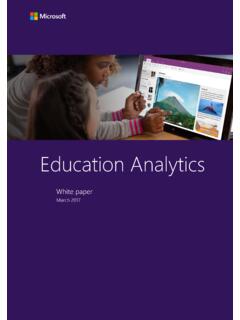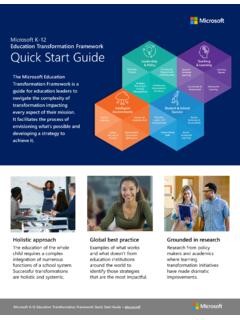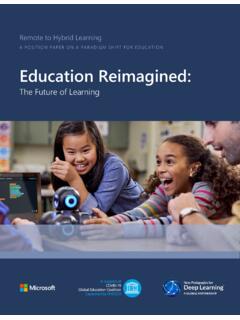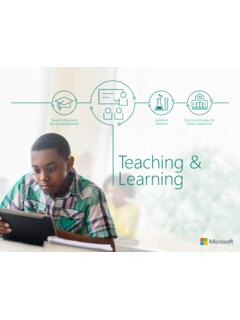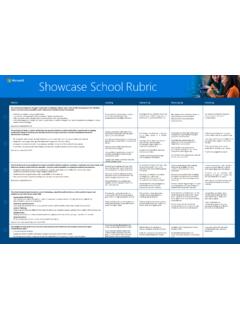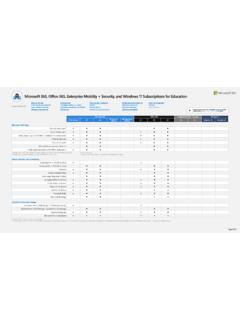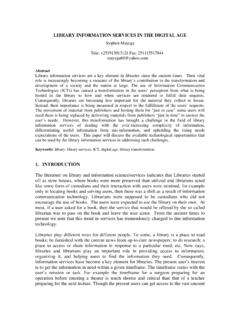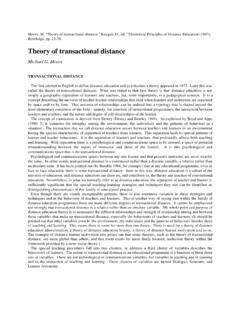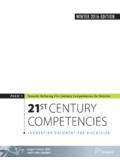Transcription of Immersive Experiences in Education
1 Immersive Experiences in EducationNew Places and Spaces for LearningWHITE PAPERIMMERSIVE Experiences IN EDUCATION1 About the authorAlice Bonasio is a technology journalist, author and consultant. She is currently Editor-in-Chief of and contributor to publications including Wired, Quartz, Ars Technica, Scientific American, Fast Company and others. Bonasio has a particular interest in Immersive technologies and is considered an influencer and expert in that field, having covered the space for several years while also consulting on digital transformation strategy and adoption of Mixed Reality solutions for a wide range of companies. AbstractImmersive technologies are becoming more popular and accessible to consumers, and this means that we are starting to see their use in a wider variety of settings, including the classroom. This is a positive development for teachers and students alike. When Immersive technologies and game-based learning are deployed correctly and in a pedagogically consistent manner, they have the potential to support and expand curriculum, enhancing learning outcomes in ways which haven t been previously possible, affordable, or scalable.
2 Immersive Experiences in EducationAs with the introduction of any innovation, however, there are obstacles and challenges as teachers attempt to balance technical logistics with content that correctly supports and augments learning styles and objectives, all without losing sight of individual student needs. In 2018, Microsoft collaborated with McKinsey & Company to publish the Preparing the Class of 2030 research study. This mixed-methodology research identified three key technologies as showing greatest promise in supporting personalized learning and social and emotional skills; mixed reality tools, collaborative platforms, and AI-enabled analytics. These findings were validated in 2019 when Microsoft commissioned further research with the Economist Intelligence Unit to examine the Emotion and Cognition in the Age of AI where, again, mixed reality and Immersive Experiences were highlighted as playing increasingly critical roles in modern paper examines the case for incorporating Immersive technology and game-based learning in educational settings.
3 This is done through cross-referencing pedagogical theory with case studies obtained through personalized email interviews with teachers, students, researchers, and technologists who have successfully deployed such technology within various learning environments and contexts. Immersive Experiences IN EDUCATION2 TerminologyWhile there is a growing consensus among experts that Immersive technologies offer extraordinary opportunities for enhancing motivation and learning across a range of subject areas, student developmental levels, and educational settings, there isn t yet a widely accepted common lexicon to which we can reliably refer, as experts continue to refine their definitions of terms in this field. virtual Reality (VR) is often used to refer to enclosed Experiences that fully immerse the user in a computer-generated environment and shut out their physical surroundings to a large degree. Augmented Reality (AR) Experiences , in contrast, superimpose digital elements onto real-world objects and backdrops.
4 As Immersive technologies evolve, a more complex and granular picture emerges. There is an entire spectrum where the digital and real worlds mix together, giving rise to the term Mixed Reality, which is increasingly gaining traction. Since this paper mostly refers to evolving Immersive technologies and Experiences in a broader context, we predominantly adopt the term Mixed Reality (MR) to describe these. IntroductionIn the field of EdTech, technology often tends to take precedence over Education , meaning that solutions are implemented without appropriate consideration and scrutiny of the pedagogical context within which they will be applied. This leads to the failure of many initiatives, because regardless of the transformative power of any one technology, its effectiveness inherently depends on coherent deployment as part of a broader strategy. This is evident in the Education sphere in particular, where success is invariably linked to effective engagement with educators, and to building responsive feedback loops that prioritize learning outcomes.
5 Research has shown that the most effective educational Experiences are those designed around social 1 Ertmer & Newby, 20132 Gee, 2003constructivist learning approaches, which involve mastering authentic tasks in the context of personally relevant, realistic This is something that Immersive technologies are particularly well-suited to provide. Simulations allow learners to not only recreate and practice routine situations, but also to access Experiences which would be out of reach due to difficulty, expense, danger, or sheer impossibility in real life. Their effectiveness, however, hinges on the ability to create conditions where the learner feels truly immersed in an environment and narrative, replicating the impact of a real-world experience . This paper explores various ways Immersive technologies, such as MR, can impact learning outcomes for example, reducing the cognitive load on the brain by allowing direct, first-person visualization of complex ideas and structures.
6 This not only dramatically increases student engagement, but also enables learners to assimilate complex information more efficiently and retain it for longer. Perhaps most important, this is achieved within a holistic context that significantly increases the rate of transfer ( , the ability to successfully adapt and apply what is learned in a variety of real-life scenarios). This transfer takes place because technologies such as MR can leverage immersion to successfully simulate a variety of realistic scenarios within specific pedagogical contexts. ImmersionImmersion refers to the mental state of being completely absorbed or engaged with an activity. It is a powerful vehicle for identity and knowledge transfer, both of which are crucial factors affecting learning outcomes. This is a principle that has long been demonstrated with game-based learning ,2 which involves taking on and playing with identities in a way that the learner has real choices (in developing the virtual identity) and ample opportunity to meditate on the relationship between new identities and old ones.
7 Learners are also given the opportunity to practice, and are supported in, transferring what they have learned to later problems, including problems that require adapting and transforming earlier learning . Immersive Experiences IN EDUCATION3A major criticism of instruction today is the low rate of transfer which sees even students who excel in schooling or training settings unable to apply what they have learned outside a theoretical context. Situated learning in well-designed digital environments, however, can lead to the replication in the real world of behaviors that have been successful in simulated the Plan, Act, Reflect (PAR) cycle, students first prepare for an experience by doing something they want to master, then attempt that performance, and finally assess what went well, what did not, why, and what they need to learn in order to execute a more successful repetition of the cycle. Immersion is intrinsically helpful for some aspects of motivation and situated learning which involves constructing an ecosystem within which students build their own learning Immersion is crucial to designing effective situated learning Experiences , and it can take several forms, such as: Psychological immersion.
8 Although it may seem counter-intuitive, basic ideas and skills are best learned in the context of attempting relatively complicated tasks that have relevance to the real This occurs because both the configuration and the coordinated team activities within this environment provide a wealth of embedded knowledge. A medical student or surgical resident, for example, will gain and retain much more knowledge by performing tasks within the realistic setting of an operating room than by reading a book. Although this is a well-recognized fact, it has traditionally proved difficult to create such unstructured learning Experiences embedded in real-world settings. Immersive Experiences bypass practical limitations such as expense, logistics, capacity, and risk. They tap into the power of psychological immersion and provide Experiences driven by social and collaborative interactions, where the setting itself contributes to fostering tacit Fraser et al.
9 , 2012; Mayer, Dale, Fraccastoro, & Moss, 2011; Norman, Dore, & Grierson, 20124 Wenger, 19985 Dede, 20096 Jacobson, 20137 Dede, 2009 Sensory immersion occurs when students can effectively feel themselves being part of a virtual world, and has been used extensively for vehicle training and other procedural learning Leticia Ahumada, a primary Education teacher who uses Minecraft: Education Edition to empower teachers to deploy game-based learning in their classrooms, observed how this use of technology increased student engagement by fostering a sense of immersion. She recalls that when she asked one of her students why they enjoyed studying history with Minecraft, they answered that, with Minecraft, they weren t studying history, but living it. I believe this is the real power of Minecraft and other Immersive technologies. For younger students that are used to playing on their tablets and watching videos on their devices, such games are their reality, so the learning is more real for them in this environment than reading a book, for example.
10 Leticia Ahumada Primary Education teacher, Microsoft Innovative Educator Expert, and Minecraft Global Mentor Narrative and symbolic immersion. Narrative is an important motivational and intellectual component of all forms of learning , and an Immersive experience can trigger powerful semantic associations. In a mediated, simulated experience , immersion requires the willing suspension of disbelief which is prompted by emotional investment in a compelling narrative. Inducing powerful immersion for learning therefore depends on designs that utilize actional, social, and symbolic/narrative factors, as well as sensory stimuli7 in order to create game-based learning Experiences that are believable from a psychological and cognitive as well as physical perspective. Immersive Experiences IN EDUCATION4 Students report a greater understanding and appreciation for the development of VR content after engaging in 3D animation and/or game design projects.
